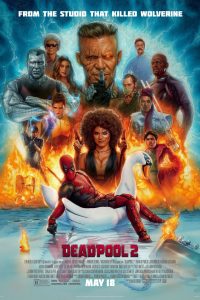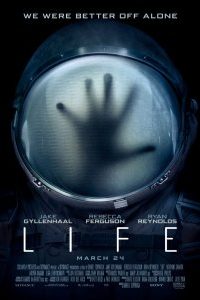The Right Stuff… and Some Wrong Stuff: A Review of Apollo 18
by Gary Westfahl
 As one watches the assemblage of mismatched footage – sometimes sharp, sometimes out of focus, shaky, or inadequately lit – that makes up Apollo 18, and still becomes enthralled by its unfolding narrative, a message emerges that is entirely unrelated to its story, one also conveyed by the film that this one will inevitably be compared to, The Blair Witch Project (1999): people today are increasingly bored by the carefully polished productions of contemporary Hollywood, with scripts worked over by sixteen teams of writers to iron out problems and appeal to every conceivable viewer; lavish, state-of-the-art special effects crafted by hundreds of experts; scene after scene meticulously edited and scored to elicit the desired emotional reaction at precisely the right moment; and last-minute reshoots to eliminate any aspects of the film that displeased a succession of test audiences. Instead, they would rather stay at home and watch their peers’ homemade videos on YouTube, craving entertainment that offers a sense of raw authenticity despite myriad imperfections. And, as Hollywood gradually awakens to this situation, there may come more and more films like Apollo 18 which will employ all of the sophisticated tools of contemporary filmmaking to simulate the work of untrained amateurs. (For while this film’s budget of $5,000,000 is tiny in comparison to your typical blockbuster, it vastly exceeds the estimated $60,000 spent on The Blair Witch Project, and the end credits reveal that there was enough money available to hire the usual army of technicians and support personnel, so much so as to suggest some featherbedding – I mean, did a film with only three actors and a few snippets of radio voices really require two “dialect coaches”?)
As one watches the assemblage of mismatched footage – sometimes sharp, sometimes out of focus, shaky, or inadequately lit – that makes up Apollo 18, and still becomes enthralled by its unfolding narrative, a message emerges that is entirely unrelated to its story, one also conveyed by the film that this one will inevitably be compared to, The Blair Witch Project (1999): people today are increasingly bored by the carefully polished productions of contemporary Hollywood, with scripts worked over by sixteen teams of writers to iron out problems and appeal to every conceivable viewer; lavish, state-of-the-art special effects crafted by hundreds of experts; scene after scene meticulously edited and scored to elicit the desired emotional reaction at precisely the right moment; and last-minute reshoots to eliminate any aspects of the film that displeased a succession of test audiences. Instead, they would rather stay at home and watch their peers’ homemade videos on YouTube, craving entertainment that offers a sense of raw authenticity despite myriad imperfections. And, as Hollywood gradually awakens to this situation, there may come more and more films like Apollo 18 which will employ all of the sophisticated tools of contemporary filmmaking to simulate the work of untrained amateurs. (For while this film’s budget of $5,000,000 is tiny in comparison to your typical blockbuster, it vastly exceeds the estimated $60,000 spent on The Blair Witch Project, and the end credits reveal that there was enough money available to hire the usual army of technicians and support personnel, so much so as to suggest some featherbedding – I mean, did a film with only three actors and a few snippets of radio voices really require two “dialect coaches”?)
Here, however, I would rather focus on another message embedded in Apollo 18 about space travel and the ways that it is typically presented in films. Today, it is safe to say, interest in the American space program is at an all-time low, as evidenced by the fact that the government has now effectively abandoned its manned space program, hoping that private companies will step in to do the work, with only the faintest of public outcries. In the 1970s, the era depicted in this film, such a decision would have been both unthinkable and politically untenable. Pondering why the space program has lost its appeal, one might note that contemporary young people have grown up in a world where the most ubiquitous portrayals of space travel have involved a man sitting on a comfortable chair in a spacious room, facing a television screen, his placid life of watching the stars go by regularly interrupted by encounters with various friendly and unfriendly people who look and think exactly like he does except for their funny makeup. Granted, incarnations of Star Trek and similar dramas have been and continue to be very popular, but it is hard to discern anything that is genuinely challenging, or genuinely different, about the stories they present. And if this is all that space travel has to offer – further adventures that are precisely the same as the adventures humans have long experienced on Earth – then what, really, is the point of actually going into space, if people with pointy ears represent the most striking novelty we are likely to encounter?
This is why I am more intrigued by films that depict space travel as it really is and always will be: people wearing bulky spacesuits to protect them from the vacuum of space, dealing with the difficulties of zero or low gravity, confronting and overcoming the many hazards of a strange and constantly threatening environment. There have been a number of such films, as documented in my forthcoming book The Spacesuit Film: A History, 1918-1969: a handful of visionary precursors like Fritz Lang’s Woman in the Moon (1929); Destination Moon (1950), the film that first brought realistic space travel to a wide audience, and its immediate successors like Project Moonbase (1953) and Riders to the Stars (1954); later big-budget productions like 2001: A Space Odyssey (1968), Countdown (1968), and Marooned (1969); and more recent films like Sunshine (2007) (review) and Moon (2009) (review). And I include in this tradition the televised (and well-rehearsed) moon landings of the Apollo program, the most expensive and authentic spacesuit films ever produced, which this film meticulously imitates (and sometimes borrows from). But there are interesting signs that the filmmakers were aware of some fictional predecessors as well: the introductory home movies of the astronauts at an outdoor barbeque perhaps refer to the similar gatherings that began almost every episode of the television series Men into Space (1959-1960); an early scene of an astronaut reaching for a pen floating in his space capsule seems a homage to the first image of space travel in 2001, Heywood R. Floyd’s similarly weightless pen; repeated scenes of spacesuited astronauts accompanied only by the sound of their heavy breathing recall the spacewalking sequences of 2001; the first surprising discovery of the astronauts precisely mimics the conclusion of Countdown; and when the lunar module loses contact with Earth at one point, commander Nathan Walker (Lloyd Owen) goes outside to fix the antenna, a problem that has forced astronauts to leave their spaceships in films ranging from Destination Moon and 2001 to Sunshine.
As someone who has watched many spacesuit films, as well as all of the moon landings on television and in later documentaries, I find what command module pilot John Grey (Ryan Robbins) terms the “strange beauty” of the Moon and outer space, and their true dangers, more than sufficiently entertaining, and I am surely not the only person who feels this way. Thus, given their premise – that the United States launched a final, secret Moon mission in 1974 which was extensively filmed but never divulged – writer Brian Miller and director Gonzalo López-Gallego might have crafted an enjoyable film about an imaginary space flight featuring unexpected but plausible perils, like the fictional Apollo 18 mission which concluded James Michener’s novel Space (1982) and its miniseries adaptation (1985). But the conventional wisdom in the industry is that such films are box-office poison, a conclusion not entirely unsupported by the available evidence; after all, most spacesuit films have not been hugely profitable, and the ratings for the televised moon landings steadily plummeted. Thus, while one can admire the courage of filmmakers who defy conventional wisdom and seek to attract audiences with realistic space films – which has been done, can still be done, and desperately needs to be done – it is hard to criticize Miller and López-Gallego for falling back on Hollywood’s time-tested strategy for enlivening purportedly dull spacesuit films: introducing complete nonsense.
The nonsense presented in the unrealistic space films (as discussed in my book) traditionally follows three generic patterns: the melodrama of conflicts with human villains or human-like alien villains; the comedy of incompetent astronauts implausibly bumbling their way through space; and the horror of astronauts confronting monstrous aliens, or being transformed into monsters themselves. Now, reviewers should not provide too much detail about precisely what transpires in Apollo 18, but noting that the Internet Movie Database first identifies the film as “horror,” one might simply comment that this film follows one thoroughly traditional path. Indeed, one sad thing about Apollo 18 is that its descent into nonsense is so dishearteningly derivative, and one might be forgiven the observation that its plot devolves into a blatant ripoff of Starship Troopers 2: Hero of the Federation (2004) since hopefully very few readers have had the misfortune of watching that wretched, direct-to-video film. Further, in the nature and home base of its horrors, one might detect a tribute to the most notoriously idiotic scene in the most notoriously idiotic spacesuit film, Cat-Women of the Moon (1953), or perhaps a nod to the nickname given to the very first lunar module which orbited the Earth as part of the Apollo 9 mission. (If any of these comments constitute “spoilers” for you, consider yourself properly punished for a lifetime of watching bad movies and remembering too much trivia.)
While Apollo 18 can be criticized for its ultimately unadventurous story, no one can say it is uninvolving; for López-Gallego employs his unusual techniques quite effectively to keep his audience raptly attentive throughout its briskly related narrative. (The entire film, including its typically interminable credits, is only 88 minutes long.) And, if I was capable of watching a film without thinking about it, like one of my recent critics, I would have enjoyed the film without reservations. Unfortunately, I am not that kind of person, and anyway, there may be some things about film reviewing that I still need to figure out, but isn’t thinking about films what a film reviewer is supposed to do? And so, instead of contentedly munching popcorn and enjoying the show, I take notes and ponder mysteries. For example: since the filmmakers wished to reference the Watergate scandal (to reinforce the notion that the government sometimes secretly does evil things), their Apollo 18 flight had to take place sometime between the summer of 1974 (when the full extent of Richard Nixon’s perfidy came to light) and July, 1975 (when the actual final Apollo mission, the Apollo-Soyuz rendezvous, occurred); but why did they have the flight take place on Christmas Day, 1974? Perhaps they only hoped that their film, if nothing else, might someday be remembered by somebody planning a film festival of “Bizarro Christmas Movies” (which could also include Will Smith’s mutant-bashing I Am Legend [2007] [review]); perhaps they liked the idea of ending their film with the Christmas carol “We Three Kings of Orient Are,” casting its trio of astronauts as Three Wise Men whose long journey led to something considerably less pleasant than the Son of God (though their profanities in response to increasingly disturbing events do include some instances of “Jesus Christ”); perhaps the filmmakers wished to recall America’s first flight to the vicinity of the Moon, Apollo 8’s orbital mission, which also reached its climax on Christmas, so that a final lunar flight on the same day would in a sense provide the program with a sense of closure; or perhaps, most prosaically, since this film’s announced released dates have ranged from April, 2011 to January, 2012, it was once penciled in for a December, 2010 release and reedited accordingly.
Other mysteries: when astronaut Walker brandishes a hammer as a weapon, is that a reference to Hammer Films, the company that produced innumerable horror films as well as its own inane lunar adventure, Moon Zero Two (1969)? Or is it supposed to recall the hammer employed by Apollo 15 astronaut David Scott (along with a feather) to replicate Galileo’s famous experiment at the Leaning Tower of Pisa? Is the name of astronaut John Grey intended as a sly nod to counselor John Gray, author of the astronomically-titled Men Are from Mars, Women Are from Venus (1992)? Given that actual astronauts of the 1960s and 1970s projected an almost mandated commitment to domesticity, with their wives and children regularly on display, isn’t it odd that only one of these astronauts – pilot Benjamin Anderson (Warren Christie) – is married with one son, while Walker is divorced and Grey is only engaged? Could this be intended to suggest that NASA, knowing full well that this mission would be far more dangerous than advertised, deliberately maximized the use of astronauts with minimal family ties? Was the film’s most horrifying image deliberately modeled on Lon Chaney’s memorable portrayal of The Phantom of the Opera (1925), or was it just my imagination?
If these musings seem far-fetched, the attention to detail one must posit to make them seem plausible is, in fact, displayed throughout the film, another one of its virtues. Its filmed images of spacecraft and the lunar surface are realistic enough that they can be intermingled with actual footage from the Apollo missions without anyone noticing (though this conspiracy-positing film was conspicuously produced without any cooperation from NASA); its astronauts are filmed using cameras built by Westinghouse, just like the actual Apollo astronauts; and when the planned Russian lunar program comes up, the information presented is equally accurate. Indeed, except for its central revelations (which are utterly ridiculous for several reasons I cannot explore), the only lapse in the film’s aura of authenticity that I could detect involves the fact that, in order to fully relate their story, the filmmakers had to include some footage which could not possibly have been filmed by any camera prepositioned by NASA or carried by astronauts.
If Apollo 18 does succeed in attracting an audience with its story about space travelers wearing spacesuits and flying in authentic spacecraft, its lasting impact may be to inspire other films about actual space flights of the past (preferably without the nonsense), or similar space flights in the near future, which would represent a stimulating alternative to the many films about space travelers wearing Spandex bodysuits and miniskirts. To space enthusiasts, it must indeed be discouraging to realize that the Apollo 11 moon landing – arguably the most important event of the twentieth century – has been accurately depicted only in an obscure television movie, while to bring the exploits of Neil Armstrong and Buzz Aldrin to a theatrically released film, it was deemed necessary to introduce talking flies (Fly Me to the Moon [2008] [review]) or evil alien robots (Transformers: Dark of the Moon [2011]), testifying to the unpopularity and marginalized status of realistic space travel in today’s popular culture; and what Apollo 18 adds to its similar story is, in the final analysis, not much better than that. Realistic films without such embellishments just might play a role in educating people about the true challenges of outer space and encouraging support for future initiatives, tasks that further installments of Star Trek, Star Wars, and other such franchises simply cannot fulfill. True, as I have argued elsewhere, it may be that the time is not yet right for vigorous efforts to colonize space, but it is sad to think that one reason for the indefinite postponement of such endeavors may be an entertainment industry that still feels compelled to associate space travel solely with absurd fantasies of mayhem, mirth, and monsters.








Pingback:Review: Lunar-based ‘Apollo 18′ only small step for found-footage – Green Bay Press Gazette | Technuts Research
Pingback:Apollo 18 Movie Review – Shockya.com | Technuts Research
Pingback:Apollo 18: Could NASA Launch a Secret Moon Mission? – Fox News | Lower Peninsula News
Pingback:Apollo 18 – Stretched Thin – Arizona Reporter | Flagstaff AZ News- Weather – Jobs – Hotels – Travel and More
Pingback:‘Apollo 18′ a product of cats on meth? – Mid Columbia Tri City Herald | Flagstaff AZ News- Weather – Jobs – Hotels – Travel and More
Pingback:‘Apollo 18′ Movie Review – About – News & Issues
I’m assuming the dialect coaches were for all the technical astronaut speak. I recall- Jodie Foster talking about the dialog is Contact where none of the actors knew what they hell they saying — but like Apollo 18, the end result sounded pretty good.
Dr. Phil
Pingback:Locus Online Reviews » The Right Stuff … and Some Wrong Stuff: A Review of Apollo 18